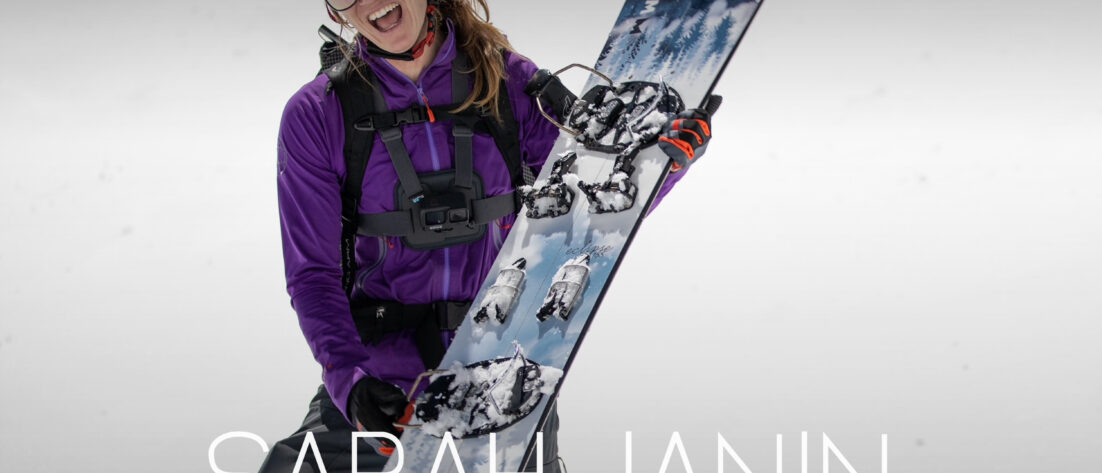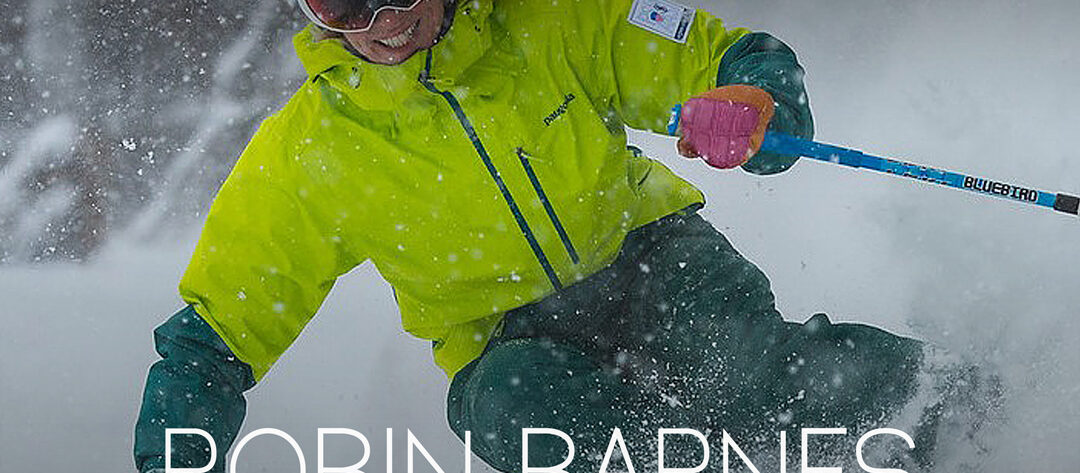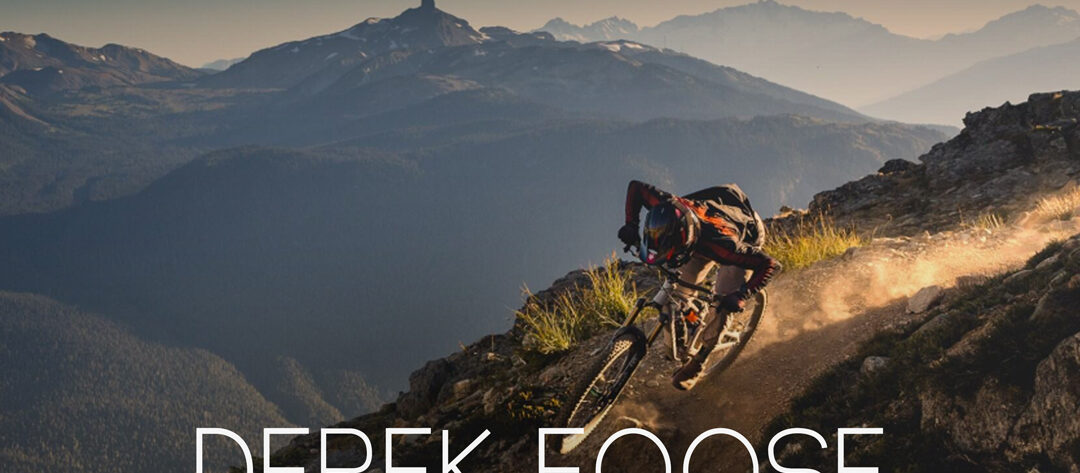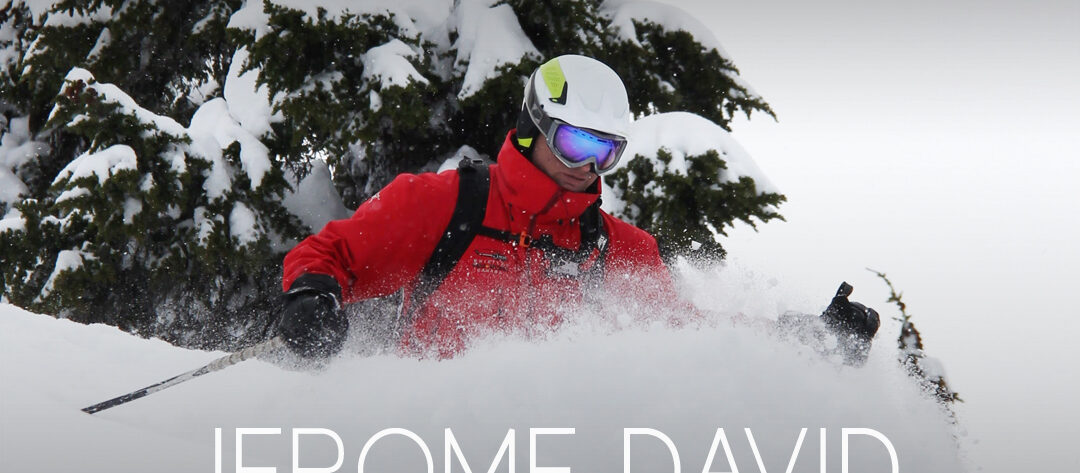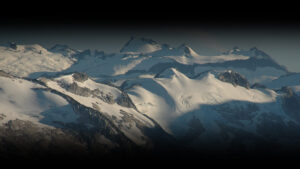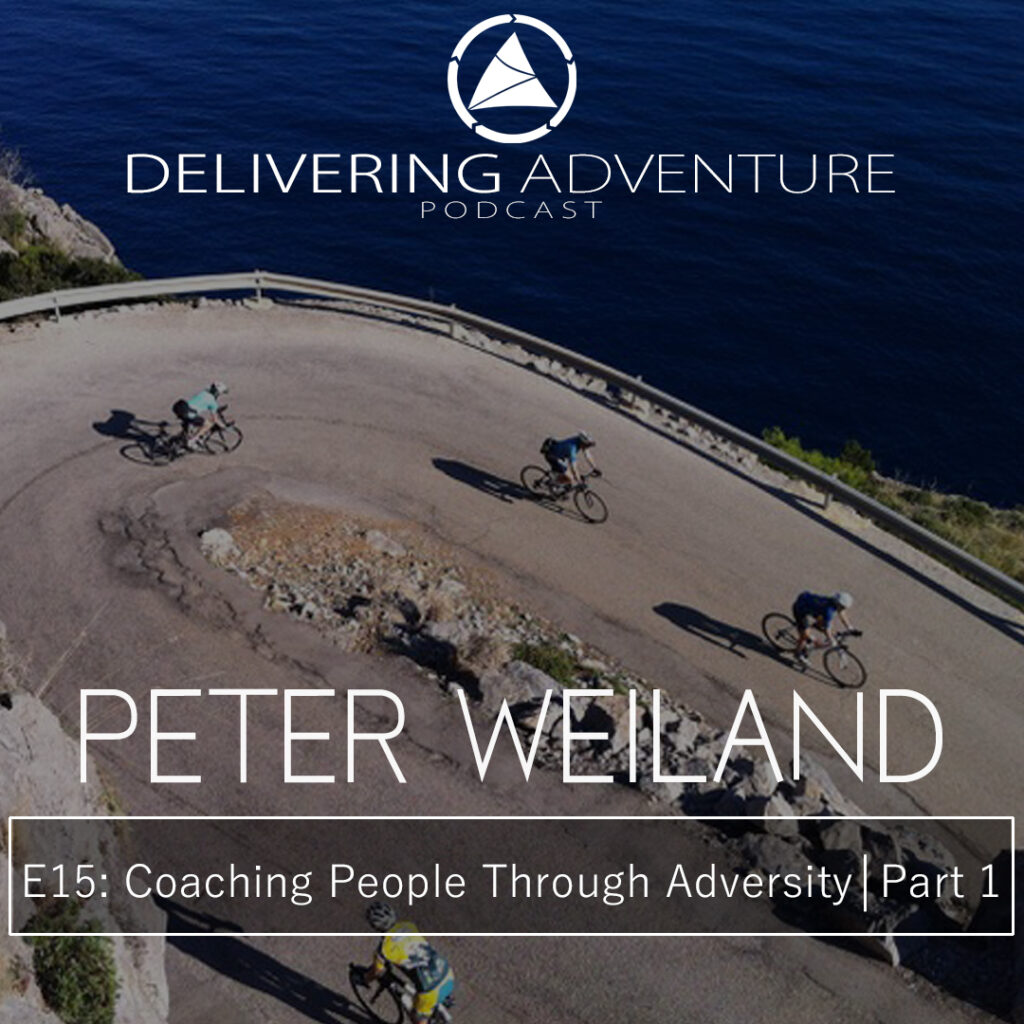
Coaching people through adversity – Part 1 with Peter Weiland
Peter Weiland shares his perspective on why we need adversity and what takes to overcome it. Peter is a former semi-pro adventure racer, former owner of Rocky Mountain Cycle Tours and currently manages a youth soccer program. Using stories from some of his most epic moments, Peter reveals what it takes to power through adversity both for ourselves and how to help others.
Key Takeaways
You don’t have to go far to test yourself: Adventure can be close to home.
Starting people off with a little bit of adversity is better than too much: When exposing people to challenge, danger, and discomfort, start slowly and build up, instead of diving straight into the deep end. This is especially important when people have lower risk tolerance and resiliency.
It is often easier to increase adversity than it is to dial it down: It is easier to go faster, harder, farther, and to increase the complexity than it is slow things down.
Follow or Subscribe
Liked the show? Remember to follow or subscribe!
Share & Social Links
https://linktr.ee/deliveringadventure
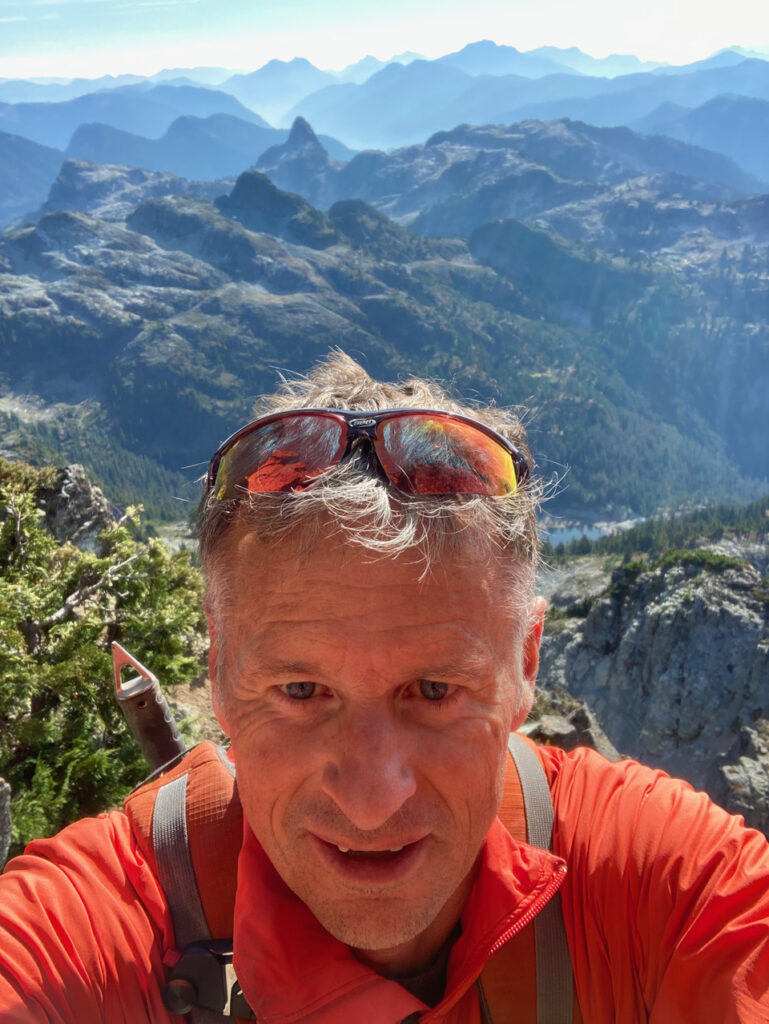
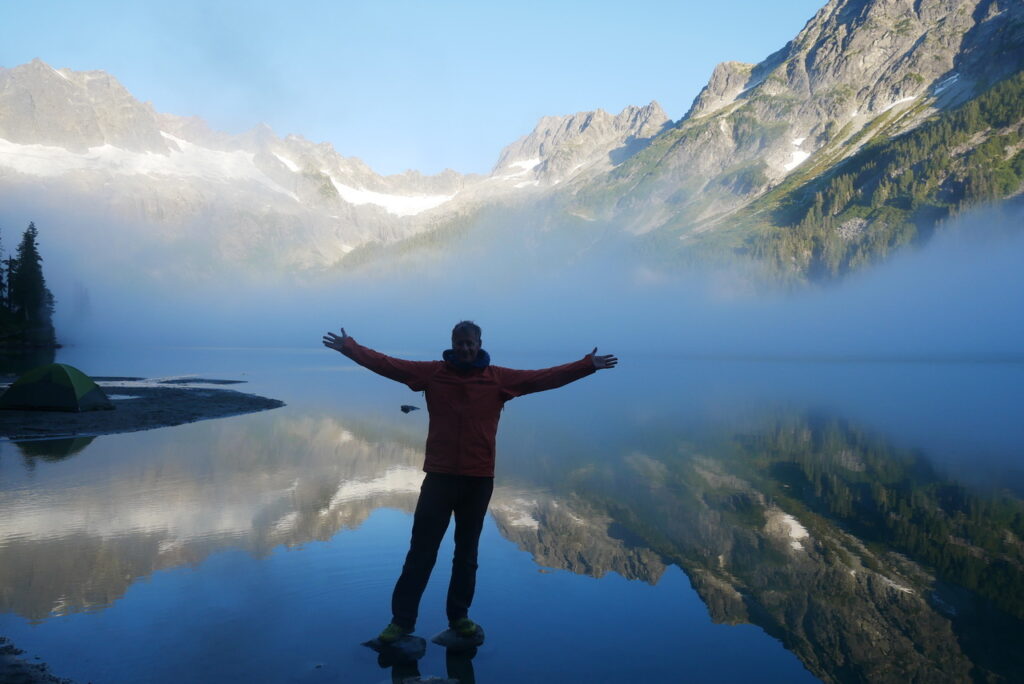
Episode Transcript
[00:00:00] Peter Weiland: It’s not even exposed. It’s just a steep slope that your site stepping up for 15 meters with the skis on your shoulders. And um, as he turned around and looked down, I guess he felt a bit woozy and let go of his skis. And so, his skis slid 50 meters down and then he just jumped and grabbed my boot. And so here I was standing on span’s ladder and an adult clinging to my boot.
[00:00:28] Chris Kaipio: This is Delivering Adventure. Welcome to the podcast that explores what it really takes to share adventure like a pro with your friends, your family, and as a profession. My name is Chris Kaipio, and I’m coming to you from Whistler, British Columbia.
[00:00:49] Jordy Shepherd: And I’m Jordy Shepard, recording from Canmore, Alberta.
After a lifetime of working extensively in different parts of the adventure guiding industry, Chris and I have teamed up to launch this podcast. In each episode, you’ll hear top adventure guides, managers, marketers, and athletes share their best stories, advice, and trade secrets. The goal of this podcast is to share how you can take yourself and others farther from the mountains to the office and.
In this episode, Peter Weiland joins us to talk about how we can help ourselves and others to embrace adversity. Peter is an X semi pro adventure racer and the former owner of Rocky Mountain Cycle Tours. Peter currently serves as a technical director for the youth soccer program in Squamish, BC where he lives with his family.
In recent years, Peter has helped to grow that program to over 700 kids, which is an amazing achievement. Chris, I think you know Peter pretty. That’s right
[00:01:45] Chris Kaipio: Jordy. My connection to Peter is that my partner, Jeannie and I ran a hiking tour in the Canadian Rockies for Peter for 15 years. I also teach skiing with him in Whistler here.
I can tell you that Peter was one of the best people that I’ve ever worked for, and he is amazing at seeking out and powering through adversity. This is why I think he is the perfect person to speak on this subject.
[00:02:12] Jordy Shepherd: Chris and I recall working for, indirectly for Peter, uh, a number of years ago where you were running his program in the Rockies and you asked me to come out and, uh, do some mountaineering guiding with one of the clients there.
So yeah, I’ve done a little bit of interaction with Peter professionally as well. So, let’s bring Peter into the DA Studio. And just as an aside, this is the first part of a two-part series as Peter had quite a bit to share on this topic.
Welcome to the show, Peter. Great to have you on here. Peter thanks for joining us today. Are you in Whistler, Squamish?
[00:02:47] Peter Weiland: Squamish, Squamish, British Columbia, just south of Whistler. We have the ocean and the mountains.
[00:02:54] Jordy Shepherd: Awesome. It’s beautiful there. Uh, can you tell us a bit about yourself and, uh, just let us, let our guests know who you are and what you do.
[00:03:01] Peter Weiland: Yes, I guess. Uh, I immigrated to Canada in 1993.
Um, lived for a few years in Vancouver, then moved up to Squamish. I’ve, uh, I’ve been married to my wife, uh, since the mid nineties, 26 years going strong. We have three kids, uh, two of my boys. They’re adults now, 21 and 18, and our daughter. 14 years old, still lives with us at home. Actually, she’s 14 now.
She’ll give me a hard time for not knowing this. So maybe we should redo this right away. Um, but um, yeah, for 20 years we, uh, my wife and I, we ran and operated Rocky Mountain Cycle tours and, um, In Squamish now I’m, uh, looking after our soccer club as the technical director, and in the winter I still ski, instruct, um, private lessons in Whistler.
That’s how I come to know Chris quite well.
[00:04:00] Jordy Shepherd: Awesome. And yeah, a few years ago we were just talking about it offline there, but, uh, I, you hired me to help out, uh, doing some scrambling and climbing with a, a guest of yours in the Canadian Rockies here, which was excellent.
[00:04:13] Peter Weiland: The last pre covid year, right? 2000.
Yeah.
[00:04:17] Jordy Shepherd: Yeah, exactly. And then that little virus hit the worldwide stage and the rest is history.
[00:04:23] Peter Weiland: Right. Changed everything. Um, we also, uh, sold our company that fall, so it was kind of a lucky, um, timing for us, I
[00:04:35] Jordy Shepherd: guess. Yeah, I heard about that. Yeah. Yeah, that worked out. So, our topic today, Peter, is, uh, embracing adversity.
So, we’ll start off with asking you, uh, what does adventure mean to you?
[00:04:48] Peter Weiland: I guess it’s, uh, excitement, daring, a little bit of uncertainty. Um, a sense that there is some danger that some things could go wrong. Not exactly knowing the outcome. For me, it always has to do. Being immersed in wild places, um, amazing nature experiences and for me it also has that aspect of pushing physical limits a bit.
And I come from that endurance, uh, outdoor athlete background. And, uh, so most of my adventures have a little bit that component in it as well.
[00:05:25] Jordy Shepherd: And what country did you immigrate from? Germany and, uh, maybe, maybe just describe a little bit of the diff, like the reason why you came to Canada in terms of, of adventure.
[00:05:38] Peter Weiland: Well, I guess I grew up right in the heart of the. Industrial heartland of Germany where you’re far away from mountains, oceans, and beautiful untouched places. And so, um, me, like many other Germans always dreamed about going to wilderness places, having great wilderness experiences. And so, Canada is usually top of the list for many Germans, right?
I think when you look at places like Baron Lakes or West Coast Trail, um, it’s mostly Germans, west tourists that you meet there. Um, and so. Yeah, it was, uh, initially an adventure trip to Canada, a 4,000-kilometer bike rides starting in Calgary through the Rockies to Vancouver, mixed in with a lot of hiking in the Rockies and the West Coast Trail.
And then continuing on to San Francisco, um, that initially, um, captured, uh, or made me love Canada. And uh, that was in 1991. And then in 93 I had the opportunity to. Come work here for a German company initially, and then four years later fully immigrate. Very cool.
[00:06:46] Jordy Shepherd: And you’ve been delivering adventure for, uh, quite a while with your business there.
What does delivering adventure mean to you?
[00:06:53] Peter Weiland: Well, I guess it’s, um, it, it started with that desire to, uh, give others, others the opportunity to experience wild places. With the same joy that I felt when I was venturing out into wilderness places, or even just cycling the Ice Fields Parkway between Ban and Jasper, where around every corner you feel like you’re riding through a postcard.
And, um, so I, I felt like it should be, I should help others to, to have similar experiences and make them possible for them.
[00:07:28] Jordy Shepherd: Nice. And you feel like you’ve been able to do that?
[00:07:32] Peter Weiland: Uh, yes. Uh, many times you’ve heard at the end of the trip, this was one of the best weeks of my life, right? Or in skiing, we often hear, Chris, you probably hear that too, when you think it was an average ski day and guests are just overjoyed and say, this was the best ski day of my life.
And then you feel you’ve accomplished that. You’ve, um, led them into places they. Go otherwise themselves or, and you made it feel safe enough that, uh, that they can experience something amazing. Yeah.
[00:08:04] Jordy Shepherd: Uh, Chris and I have gotten to do that quite a bit through our guiding careers and delivering adventure, and it is quite rewarding to have that, have those comments.
And maybe to us it’s been an average day or maybe not even anywhere. Best day ever. And, but, uh, yeah, it’s all, it’s all, uh, their perspective, right? And, and, uh, delivering the.
[00:08:28] Peter Weiland: Yeah, I guess it’s, um, all the elements that we feel when we think about adventure, excitement, daring, uncertainty, a bit of danger. We want the guests to think that exists around them too.
But as guides and operators, we want to eliminate it as much as possible as well. Right? Or have planned ABC in place for, uh, for what happens when, right.
[00:08:53] Jordy Shepherd: Yeah, it seems like a smooth delivery to them and we’re constantly dialing it up, dialing it back, moving things along, uh, making decisions all the way along.
And so oftentimes they don’t even know that we’re doing that.
[00:09:06] Peter Weiland: Yes. Yeah. It’s even in a, when you think of an ordinary bike ride in the Canadian Rockies, um, I always tell the guests there’s no such thing as a warm rain in the Rockies. And when you’re on a bike and, uh, the weather forecast doesn’t come in as you expected it, uh, even an ordinary bike ride between BAM and Jasper can turn into an adventurous situation with people very quickly getting cold.
And you have to deal with that and, and so, um, yeah, definitely having those backup plans and quickly changing plans in mind and options to deal with it. Yeah.
[00:09:46] Jordy Shepherd: How did you get into the adventure guiding industry? What brought you to that and starting the business.
[00:09:51] Peter Weiland: the opportunity was offered to us to, um, to buy this business, Rocky Mountain Cycle Tours.
Um, It, uh, it had been started in 1977 and the owners then wanted to retire and sold it to a rafting company, and they didn’t quite know what to do with it. And so, it wasn’t a sense, uh, starting a new business at that time, but with all the business licenses for the national parks in place. And so, um, my wife and I, we went for that and, um, that’s how it started in 1999 for us.
Yeah.
[00:10:26] Jordy Shepherd: And how did it evolve over the years for you?
[00:10:29] Peter Weiland: We figured we needed to grow the company to make it financially viable. We, um, also looked at branching out and other options and offering not only our own tours, but um, white label operating for. Larger companies that gave us a fairly consistent flow of, uh, customers like REI Adventures in the States.
And so, um, that was a really great second leg to stand on for us. Fairly, um, continuous stream of revenue at lower margins than our own tours. But, um, just a large operator that has access to a very large market helping, uh, to fill trips. So that was, um, A really good way to branch out for us and minimize risks financially a little bit.
[00:11:16] Jordy Shepherd: Awesome. I’m glad it worked out for you. Tell us about the Camel Trophy. What is it and how did you get involved with it?
[00:11:23] Peter Weiland: Camel Trophy is a marketing event for Land Rover that, uh, ran for 20 years. And, uh, I was part of the last Camel Trophy in 1998. Um, was the last one I guess, because Land Rover had run into financial troubles and then was bought out by BMW and they, they canned the event as they found it too expensive.
But, uh, it, it ran for 20 years and it started out as a really rugged. A vehicle-based adventure event, um, where teams would cross the jungles of Borneo or the steps of Mongolia, and it was very much, um, Vehicle based, like how could you get across that river and all 20 teams work together and build a wooden bridge in the jungles of bonne or a raft to get all their vehicles across.
Um, but the trophy evolved as Land Rover was building different vehicles and, uh, the one they wanted to market in 1998 was, uh, the little Land Rover Freelander. Um, that is basically a vehicle that gets you to the trailhead, um, in one piece, but, but not really like that offroad four by four that you want to take through the jungles of bono.
So, the, the 1998 camo trophy was, um, tweaked a little bit in a way that it was geared as an adventure rally race. With driving to the trailheads. And then from there you would, um, skin up the volcanoes or you would paddle, um, across a lake, uh, to locations. And it was structured in a way that you would given, would be given a whole book full of locations all across Patagonia, Chile, and Argentina.
Um, you could plan your own route depending on the strength in your team and strength of outdoor skills that you. and, um, the idea was to drive to a location and then put on your skis or hop on the mountain bike and find that, um, marker that would give you, um, a proof that you made it to that location.
And depending on how, how difficult or how long it took, there were points awarded for that. So, the, the format of the race was that from sunrise to sunset, you were allowed to collect points. You couldn’t collect points at night, but you were allowed to drive at night. So, the strategy that evolved was to.
To collect and get to as many of these, um, places during the day and then, uh, take turns driving through the night while sleeping, while the partner was sleeping. Um, so you would be next morning in the next location. And so, after four days, and obviously everyone was exhausted, so he had a 24-hour rest day and that would repeat, uh, there were four segments or four days with rest days in between, and we made our way from.
Santiago de Chile all the way to Tierra del Fuego, uh, and drove a total of 7,000 kilometers in those, uh, 16 days plus got to a top of volcanoes and, and, um, paddled rivers mountain biked, uh, and, and tracked through wild areas. But, um, I think he started out how. To do this. So, um, my initial employment in Canada ended in 1997.
My wife was still finishing her, uh, university diploma in Germany. And so, I decided to go back for a year to Germany and, um, started with a friend of mine, a little, uh, event. Organizing company or, and we, we put on a few local adventure races and then I saw this, um, um, this ad and, uh, I think it was a TV ad, um, to apply to be on the German team for the Camel Trophy.
And so, because I had a bit of time on my hands, I applied, um, they liked my resume and so they invited about 150 of us. Um, to an old Army training camp in East Berlin and, uh, had all of us, um, do Orienteering races and, uh, fitness tests and drive some vehicles and see if we could drive a vehicle and not fall off the trail.
So, and then they narrowed it down to, after this weekend, I narrowed it down to a group of. I think 16 of us who were invited to the Car Mountains in Georgia and we did another selection week there. Um, again, driving Land Rovers, uh, skinning up to peaks. Um, a lot of volunteering, GPS and Compass based. Um, and out of those 16, there were four of us selected to go for a week to Sweden, uh, near the ski area of a and, uh, we did another selection week there, um, this time already with all the European nations there competing.
And then in the end, two of us were asked to compete for Germany in, in, uh, Patagonia. Yeah. Wow. Quite the process. It was, yes. Yeah, there were 15,000 applicants actually, so, and I was, uh, lucky to be on the end of it.
[00:16:52] Jordy Shepherd: Yeah. No kidding. Nice. So, we’re talking about embracing adversity here, and that’s part of it, uh, what you just spoke about.
What advice would you give to others who might find themselves operating as part of a team in, uh, a really physically and mentally demanding situation, like an adventure? Any advice?
[00:17:11] Peter Weiland: Yeah, so, um, I think when you, when you compete in like a multi-day adventure race where everyone gets tired, at some point, I think you want to know your teammates well, and you want to know each other’s strengths and weaknesses.
You also want to. Have the opportunity to take a step back when you’re just drained and let someone else take the lead and talk about those things beforehand. We found in adventure racing that our teams were strong because we had people who could. We had more than one person who could navigate. Um, when I think back to the eco challenge in 1996, a lot of teams were made up of, uh, triathletes and they, they took on one mountain guide or so, uh, to, to lead the team through the mountains navigating.
But when that person was drained and couldn’t focus anymore, there was no one else to, to take over that role, for example. Right. And. Yeah, so it’s just, um, knowing your roles, knowing your strengths and weaknesses, um, trying to figure out how, when to step back and let others take a lead. So, um, I guess those are the most important, uh, lessons to take away from that.
[00:18:29] Chris Kaipio: Peter, what’s the craziest thing you’ve ever.
[00:18:31] Peter Weiland: I don’t know what’s so crazy. I think I, one of the crazier things looking back was trying to solo climb Monte Assiniboine between finishing a trip with guests on Friday at four o’clock and having to be ready and packed up with the trailer and. Uh, 7:00 AM in the morning on Sunday morning,
And uh, just realizing, going up Assiniboine that this is not going to happen, not going to go well, and that I have to turn around and go back. So. Um, but it was crazy as I just. Made it back to Sobey’s in Canmore just before they closed to get all the, the food and, and so I could feed the guests then during the week
Yeah.
[00:19:14] Chris Kaipio: Now, now that that trip wasn’t just trying to climb the mountain, but you also ran all the way there. And all the way back. Is that right?
[00:19:21] Peter Weiland: Yes. I didn’t helicopter in, so I, I ran in from the mount track trailhead. Yeah. It was those days where, just beginning days of our company where, um, I just came off the adventure racing years and still had that gene in, in me a bit
Um, in hindsight, looking back, um, I should have probably prepared differently before that trip. Yeah.
[00:19:44] Chris Kaipio: Tell us about your trip up Mt Athabasca.
[00:19:48] Peter Weiland: Yeah, that was, um, when we, um, it was on a cycling trip, Jasper to ban. And, uh, so the, um, other guide Paul and me, we had I climbing Athabasca on a day when we would be staying at the lodge there for the whole summer.
And it never materialized weather wise. And, um, so on this one day, it, uh, it didn’t seem to cooperate. Again, it was sleeting when we took guests across to the Athabasca Glacier and it was still, uh, sleeting when we sat down to dinner at six. But then as, um, as we finished dinner, we saw that it cleared up all sudden.
And so, um, Paul and I decided to go for it that night then. And so, we left, uh, after dinner. Um, The, the, one of the problems was, uh, there were lots of footsteps up the mountain and we thought we would just follow those because it’s, it’s climbed every day, right? Um, during the summer and, um, but the sleet and the snow had covered all of that, so.
Root finding was a little more involved and difficult. Took us a little bit longer, um, in the dark until the moon came up behind the mountain. Then, then it was all good. But, uh, as soon as we stepped off the glacier, um, we also had, uh, pour falls through a little snow bridge and it disappeared in a Kiva.
And, uh, so, but we were roped up, right? So we were, we had all the gear, we were roped up, we were well prepared. And so, it was. Um, that moment that made you think, okay, we, we are in a serious environment. You going to be really alert. But, uh, it was good, good preparation and nothing happened.
[00:21:40] Chris Kaipio: Can you tell us about your Moroccan eco-challenge experience? Was there a particularly memorable moment that you can share from that race?
[00:21:47] Peter Weiland: I’ll share three moments, um, because it was an amazing race and the one, I think that you have in mind, I’ll leave it to last. Um, uh, three things that really stood out for me and are really memorable was the sea kayaking down the Moroccan coast, um, which I think many had underestimated in how severe the wind and waves can be, including the race organizers.
Um, our team was quite well prepared because I had windsurfed in the Canary Islands and in the north of Morocco, and I knew about the Tradewinds at that time. We also knew that it’s a fairly cold ocean current there that is not warm. And so, um, gear wise and everything, we were well prepared. We, um, we had trained in an environment where it was very windy, but, um, the swells were immense.
And, uh, so we were, we were having kites up. Um, instead of paddling, we were having the wind pull us. But uh, these double t kayaks, as they came down the swell, the nose would dive in. And then the push of the wave was trying to push the kayak sideways. Basically, every wave we came down for this 80-kilometer trip.
And so, it took immense focus and, um, Mental energy and huge cause corrections, not only with the foot rudder, but with the paddles as well to keep the boat straight. And so, I remember that as a harrowing trip down the coast. Um, and then, um, the waves and the surf was so big that you couldn’t. Just paddle into the, there were three or four checkpoints on the beach where you had to paddle in and get your passport stamped to prove you were there.
Um, so you couldn’t paddle in and out anymore. So, they came up with the idea that you would, uh, have your kayak crew just wait outside the surf zone and one of you would have to swim in. And, and get your marker there and, and then swim out again. The problem with that was that when your little head is bobbing in the waves and there’s 50 yellow boats out there in, in quite a bay and they’re all spread out.
But we didn’t account for was how do you find your boat again? Right. And so, um, yeah, after we’ve experienced that the first time and it took a while to find our own boat and we had a paddle with some, um, with some things wrapped up. And, uh, so, so we could signal which, which boat to go to, right? The boats all look the same.
Um, and then the second moment was, um, when we got to the horseback riding section. In the previous two eco challenges that there was also horseback riding involved, but in Australia and Canada it was fairly tame quarter horses, um, who were used to carrying tourists around and, and, um, they were easy to guide.
Completely problem free. Right? But in Morocco, the horses were supplied by the American Army, so they were all Arabs deeds, and, um, really fiery horses and I figured out that you needed to be a rider to, to really do well on those, which I wasn’t. Uh, for most of the sections we were just allowed to walk the horses on mountain trails.
But then we got to this dried up Salt Lake and, um, Here. This was the only section in the race where we were allowed to counter a gallop, uh, on the horses. And so, we let loose and those horses just took off like a Ferrari, right? Those are the Ferrari among horses. And so, when we got to near the end of the lake, I figured you going to pull with all your might on those rains here to, to make that beat stop again, right?
And so, I did and it stopped on the dime, and of course, momentum carried me. Uh, it kept me going, right? So, I went straight over the front end of the horse, dusted myself off and saw my stead galloping off in the distance. Luckily, we were traveling with some members of a British team. Um, With, uh, uh, sir Ranulph Fiennes on the team who’s, uh, a friend of now King Charles.
Um, and King Charles described him at the time as the greatest living adventure on earth. Um, and so he was an excellent horseback rider, and so he. He galled off and got me my horse back. Um, at that time, I have to add, we, uh, our team already had fallen apart due to injuries and so had the British team and so had another team.
So, there were six of us together and we continued unranked, uh, as team United Nations basically. And, uh, Yeah, so I, Ranulph shared a lot about his other adventures and the book he wrote Living Dangerously and how he blew up things and undercover missions in Arabia and so on. So, it was a very entertaining into the race Yeah.
Going with him. But the, um, the final moment I think you’re waiting for Chris, right, is uh, when we got to near the end of the race, oh, actually there was still, the hiking and mountain biking section was still to come. Um, one of the local villages put on a little party for us in a transition zone. Um, and uh, this was the only place where, um, villages were kind of supplying the food in the transition zone everywhere else.
We had to have our own food with us and, um, I guess we were a little too, um, Hungry or not mindful anymore of all the precautions you want to take in Morocco with, um, with getting food poisoning. Um, which we had done pre raised very diligently, and we had all managed to stay healthy, but, uh, being hungry and tired.
So, we, we went overboard on the local buffet and then we started our night hike up, uh, the second highest peak in Morocco, j Goon. And, um, as. As the, um, night got pitch black and the moon wasn’t up over the mountain, we decided to stop at a, um, at a checkpoint just below the peak at, uh, well over 3000 meters elevation.
And, uh, as you know, in the desert and in the mountains, it gets freezing cold. Um, even though Morocco is Africa, uh, yeah, you, you experience very cold nights. Um, in an adventure race you only carried like minimum gears or mandatory sleeping bag was of the thinnest kind. Um, and so we’re all really cold as we, um, huddled up there and I put.
Every piece of clothes that I had on went in my sleeping bag because it was still so cold. I drew the draw cord on my sleeping bag tight over my head. And then, uh, when I woke up, um, a couple hours later, I was so sick and I felt, um, fluids ready to come out of both openings on my body, and I couldn’t find the draw cord above my head before I.
And draw it and get out that I had emptied, um, on both ends into my sleeping bag. Obviously soiling all the clothes and gear that I had with me, so I was not a pleasant, um, teammate to be near for the next days. And safe to say, I burned that stuff. made a sacrificial offering to the adventure racing guards,
Without sleeping back.
[00:29:25] Chris Kaipio: Peter, I think when you told me that story the first time you, um, you went on to say that you ended up, um, one of your teammates actually heard you struggling and let you out. Is that, is that true? [00:29:36]
Peter Weiland: Yes. I, because I couldn’t find the drug word and I was in a mess inside. Right. So yes, I had to open it from, from the outside
[00:29:47] Jordy Shepherd: Then they probably promptly wanted to put you back in.
[00:29:50] Peter Weiland: That’s right. Yeah, it was nasty. Yeah. Obviously, we couldn’t stay then much longer there. The, the moon, um, had come out, so we decided to start moving and luckily all the poisonous stuff seemed to have gone out of my body. So can do you have time for.
One more thing. I would like to, um, tell people that adventure can be found close to home. And, um, I was actually challenged, um, I told you initially I grew up kind of in the industrial, um, heartland of Germany, more or less. Where, where you think there isn’t, um, really those great, adventurous places around.
But when, um, when I was doing the adventure racing stuff and I was back there with the camera trophy, um, a magazine challenged us to. Do something amazing in Germany, like an adventurous health supporter. And so, we came up with the idea to paddle a sea kayak from the ski town of Obor and the Alps, uh, into the Baltic Sea, one of the northern most German islands, uh, stretch of a thousand kilometers.
And, um, The experiences along the way. In some places it looked like you were in the middle of Canada, wilderness, beaver dams and so on in other places we didn’t see humans for, um, a whole day. Um, when we paddled the Albert River, which used to be the border between east and West Germany is very unpopulated area, right.
We, we saw amazing sunsets. We saw wild. Masses of wild birds. And, uh, so it, it just shows me you don’t have to go to the arctic or to, to climb, um, uh, in unexplored places. Um, you can find great adventures. Um, near where you live and we, we just set out some parameters to make it a little more challenging that it’s self supporters.
Right? And we don’t go to every, uh, coffee shop that you could find along the way. And, uh, that we would portage our kayak where rivers were too. Um, shallow to Palo, but, uh, yeah, we connected a thousand kilometers through, um, and saw some amazing wild places of this country that I had really only experienced as mass populated.
Um, very busy looking and, and where you always think I got to go far to find amazing places. outstanding adventure so it can be found near you and you don’t have to live in a ski town or, uh, uh, in a beach resort to, to find great adventures. That’s my, my word to everyone who is, um, looking to get into adventure stuff.
[00:32:40] Jordy Shepherd: And then you just set the parameter every second coffee shop? Not every coffee shop.
[00:32:44] Peter Weiland: No, we didn’t do a single one. We had one food drop halfway. Everything else we did self support its kind of nice.
[00:32:55] Chris Kaipio: So that’s it actually one of the points that Greg Hill brought up. When we were talking to him about sustainability and how, um, sometimes you don’t have to travel that far to go and have amazing adventures. And sometimes we appreciate the adventures that we have that are closer to home because we can actually see them, you know, more often.
He referenced, uh, you know, I guess one of the trips he did, you know, in the Tantalus range. And every time he drives up to Whistler and he can see the Tanus range from the highway, it reminds, reminds him of that particular trip.
[00:33:27] Peter Weiland: Yeah. Yeah. It’s even for me, uh, like going up the Squamish chief, I’ve been up so many times the front side, but, um, because that got a bit old, I thought, how, how do we make it a bit more interesting?
So, this year I came up with the idea of doing it from the SL side and, uh, that way you can, there’s several via Ferratas in there that we can easily climb up and do all three peaks and then come down the front side. dropped my bike at the bottom and connected the whole loop. So, I did a loop and saw it from a completely different side and little bit more adventurous.
So, you can tweak things, uh, that, that you’ve done a lot of times and, and find some new adventure new sites. Yeah.
[00:34:17] Jordy Shepherd: Okay. We’re going to pause there with Peter so that we can summarize some of his key points so they don’t get buried. We’ll pick up the rest of what Peter had to say in our next.
[00:34:26] Chris Kaipio: So, when it comes to helping people to embrace adversity, I’d like to highlight two key takeaways from what Peter had to share.
The first one has to do with your sleeping bag, and I guess you need to make sure that, uh, you don’t zip yourself fully up so that you can’t escape According to Peter’s story, there.
[00:34:43] Jordy Shepherd: Yes. Good advice.
[00:34:44] Chris Kaipio: Yeah. Luckily, I’ve never had to suffer from that. Uh, the second part is that you don’t have to go very far to test yourself.
Adventure can be done close to home. This is something that Greg Hill, uh, also touched on. Um, and, you know, Peter shared the examples of, you know, the first story I think he, he shared was, um, his big adventure in, in Germany, which is. Which is pretty crazy, uh, from the viewpoint of, of most people is a thousand kilometer, uh, you know, paddling journey.
Uh, but he also just highlighted some, uh, hikes closer to home where he actually didn’t go very far at all. And then just, uh, and then just varied them. And so, um, that’s something that I just want to kind of reiterate. I know we’ve talked about this before, but it is an important part. Adventures can be close to home.
You don’t need to go a long way to. Jordy, what were some of your takeaways?
[00:35:40] Jordy Shepherd: Chris. Yeah, those were, uh, one kind of funny one and one, uh, one quite good piece of advice there. So, Peter talked about starting people off with a little bit of adversity is better than starting them off with too much, and I completely agree with, uh, all of our guiding instruction that we do.
We really want to. We really want to build people up. And if we start at too high a level, uh, it doesn’t give us time to assess them and it doesn’t give themself themselves confidence in what they’re doing. So much better to, uh, start it off kind of throttled back quite a bit and then you can always turn it up.
And that’s leads to the second thing that I wanted to talk about is, and that Peter talked about, is that it’s easier to increase adversity than it is to dial it. So, uh, start easier and. Start to go faster, harder further, and increase, increase your complexity, uh, with whatever activity or adventure that you’re doing.
Uh, but if you start off, uh, with both guns blazing and your, your, uh, you’re just going really hard, it’s, uh, it’s really hard to dial it back and dial it down in, uh, in what we’re doing for activity. So just, uh, you know, like everybody says, you’re supposed to warm up before you go do an activity. Well, this is the, this is the warming up part in terms of the adventure.
[00:37:02] Chris Kaipio: That’s a really good point. Jordy, often I find dealing with people on vacations on day one, they want to start going really hard right off the bat, and I have to. Pull them back a little bit and remind them that they need to be able to make it through their whole vacation and not burn out at the at the very start.
And so, when we’re acting as people’s guides and we’re leading other people, that’s something that we have to remind them of as well. It’s much. Easier to make things harder than it is to bring them back down again, especially once people start getting tired. Now let’s turn it over to you, the listener.
What were your takeaways? What stood out to you? You can share your thoughts story, your insights with us via our social media feeds, or by emailing us. You can find all of our contact information@deliveringadventure.com. Also, before you go, we need your help to keep this podcast going. Please take a moment to share it with your social network.
Adventure is best when it is shared. To finish off this episode, we have one last funny story from Peter.
[00:38:13] Peter Weiland: So, Spanky’s Ladder is, uh, on Blackcomb Mountain and it’s, um, the access to some three fairly amazing backcountry bowls. Or not backcountry, it’s in bounds, but, um, some nice steep skiing that almost feels like backcountry a bit.
And because you have to hike up about 50 meters, um, uh, it has that almost backcountry type feel. And, um, so for, for many guests, it’s on the list that they want to ski there. And, uh, so I had, uh, this gentleman who, um, who was a really good skier, but, uh, we hadn’t really experienced that or he had an experience that he was afraid of heights, um, or hadn’t told me.
So, as we walked, um, I guess he looked over his shoulder and it’s, it’s not even exposed. It’s just a steep slope that your site stepping up for 50 meters with the skis on your shoulders. And, um, as he turned around and looked down, I guess he felt a bit woozy and let go of his skis. And so, his skis slid 50 meters down and then he just jumped.
Grabbed my boot. And so here I was standing on span’s ladder with an adult clinging to my boot and it was a big powder day and it just opened. So, all the hardcore locals were walking by, uh, dropping a funny comment. And uh, we ended up. Slipping on our bums down to his skis to plan B. And yeah, so that was probably a more funny moment.
Yeah. The other one was, uh, when I had this guest from New York, uh, his goal was to ski every double black on whistle black home. And so, one of the last ones we did was the, uh, um, glacier UA on Whistle Mountain, which is almost in Unseeable now. Um, thanks to the glacier receding, it’s now. A huge overhanging corner at the top and maybe a two-meter-wide ravine that you can still maybe make some hops down.
But, uh, back then you could ski right from the side into it. And there was enough snow to make turns, but very steep. And so that was one of the last ones we got to. And, um, he, he looked at it for a long. Was ready to do it. Went into the first turn and leaned to the mountain, lost his edge, and then just started sliding.
And as he picked up speed, he lost his skis and poles and hat. I think it was still hats at the time. And, uh, so he slid almost down to, uh, the saddle run. Good three, 400 meters. And, uh, so I, I collected all his gear, came down and he shook himself off and dusted the snow out of his jacket. And he said, well, didn’t do that too badly. Missed only one turn. Hey.


